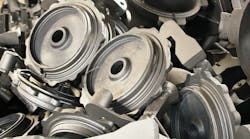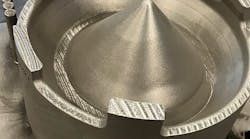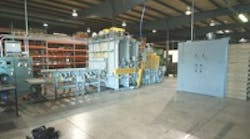Seco/Warwick Corp.'s new solution heat-treating technology — the Jet Impingement furnace, installed at TempRite Steel Treating, to process aluminum engine blocks.
Recently, a Michigan commercial heat-treater Temp-Rite Steel Treating added a new solution heat-treating furnace to process aluminum engine blocks. Of course, such products are one niche in the automotive supply chain that continues to spur the hopes of metalcasters, but automakers interest in high-quality, light metal engines is not exempt from demands for speed. The new technology, Seco/Warwick Corp.'s Jet Impingement Air Flow process, is a recently patented technique developed to reduce heattreating process time and improve work uniformity, during heating and throughout the soaking cycle.
Temp-Rite Steel Treating offers a range of metal treating services, including vacuum hardening, salt bath hardening, carburizing, atmospheric hardening, precipitation hardening, and sand blasting at its Harrison Township, MI, plant, which includes inspection and lab facilities. Temp-Rite offers heat treating for nonferrous metals, in addition to steel, including solution annealing, precipitation hardening, and aging.
Solution heat treatment involves heating an alloy to temperature, holding it at that temperature long enough to cause one or more of its constituents to enter into solid solution, and then cooling the product quickly enough to hold those constituents in solution.
Engineers at Seco (www.secowarwick.com) recognized that short-cycle heat treatment of aluminum castings was possible in a laboratory setting. Their effort to pursue its commercial possibilities resulted in a patent issued last year for a production-scale furnace that works like a conventional, mass-flow convection furnace, but offers heating rates and heating-rate and temperature uniformities suitable for short-cycle solution heat treatment.
The design looks like a roller-hearth furnace, with conventional up flow, convection heating. It has a recirculating fan in its roof. Air flow exits the fan and is directed downward; heat is introduced and the air flow is redirected upward through the rolls, and then returns to the fan inlet.
The difference in the new process is that air exiting the fan enters an expansion chamber, where the air's dynamic pressure is converted to static pressure because without any turning vanes the air impinges on the chamber's vertical wall. When the air strikes the wall there is an equal chance that it will be directed longitudinally or downwardly. As such, uniform air distribution is established.
As the air flowing downward it enters a distribution chamber, where the longitudinal distribution is completed before the air enters the jet chamber. The air exits the jet chamber through a jet impingement plate that creates high-velocity jets of air to enhance heat transfer to the product (aluminum engine blocks) moving along on the rolling hearth.
The design of the jet chamber is important, because it is responsible for achieving uniformly horizontal airflow across the jet plate. Furnace dimensions have practical limitations, and the volume of the jet chamber cannot be large enough to create uniform static pressure below the jet plate, which would create uniform airflow through the jet plate. So, the bottom of the jet chamber is either contoured or fitted with a distribution vane, to ensure that there is always more airflow at the center of the jet plate than at its edges, because of the forward velocity of the air in the jet chamber
In tests, the Jet Impingement Furnace design showed "an unsurpassed combination of mas flow uniformity, heat transfer rate, product temperature uniformity, and product temperature stability during heat treatment," according to Seco's Jack Mahoney and Paul Shefsiek. The system reportedly has achieved ±1°F product uniformity during commercial operation, with high-quality metallurgical results, better distortion control, and lower total cycle time.
Basketless Heat Treating for Engine Blocks
The new Can-Eng furnace at B&W Heat Treating processes aluminum engine blocks with lower energy consumption, and occupies less space than a rollerhearth furnace.
Another commercial heat treater, B&W Heat Treating Canada, in Kitchener, ON, recently commissioned a basketless heat treating system supplied by Can-Eng Furnaces Ltd., Global Furnace Systems Group (www.can-eng.com). This system is processing cast aluminum engine blocks, but demanding less energy to operate and consuming less floor space than a conventional roller-hearth heat treatment system.
The system uses an unusual material handling system to achieve "single piece product flow," transferring castings through the system without using baskets, carriers, or trays.
B&W Heat Treating is Canada's largest commercial heat treater, processing highvolume components like engine blocks, cylinder heads, suspension members, and steering brackets, as well as traditional heat treating services — batch and continuous case hardening, through hardening and annealing services, induction and salt bath processing. It operates two plants in Kitchener, and another in Saginaw, MI.











